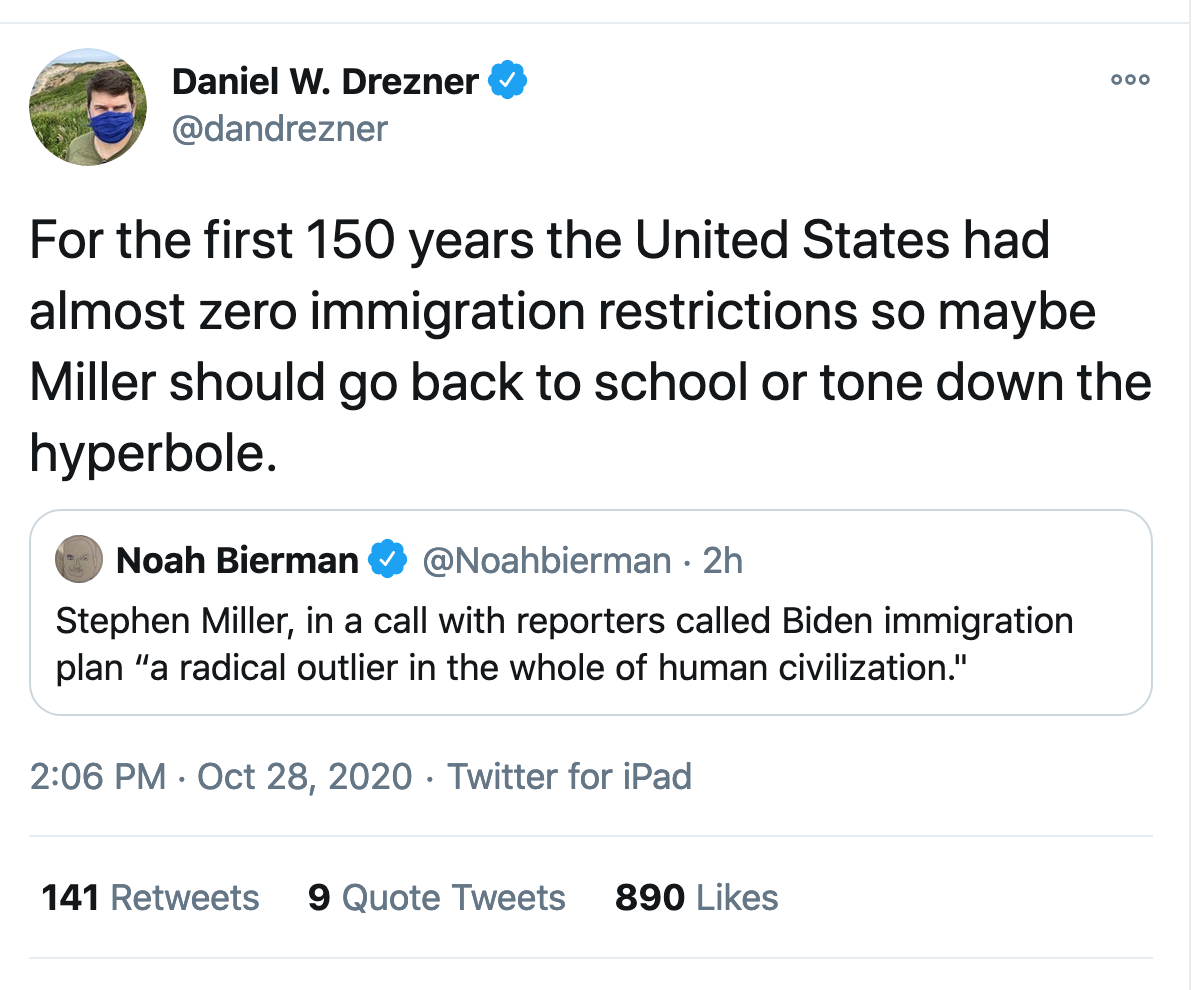The stakes for declaring the US had open borders?
It remains a popular belief even among scholars that the US had open borders before the federal government took over managing borders in the late nineteenth century. And what is the harm really in not knowing about the century of state/local antebellum restrictions on migration? Having that historical blind spot has implications for present political debates.
See for example Dan Drezner’s recent tweet that illustrates the common belief that there were barely, if any, immigration restrictions until the national government started enforcing migration controls circa 1893.
Most fail to distinguish between state and federal level immigration policies.
Indeed the US Citizenship and Immigration Services’ own website states:
“Americans encouraged relatively free and open immigration during the 18th and early 19th centuries, and rarely questioned that policy until the late 1800s. After certain states passed immigration laws following the Civil War, the Supreme Court in 1875 declared regulation of immigration a federal responsibility. Thus, as the number of immigrants rose in the 1880s and economic conditions in some areas worsened, Congress began to pass immigration legislation.”
And really, what is the big deal whether the US had “almost zero immigration restrictions”, or that the US “encouraged relatively free and open immigration”? Here are several reasons why acknowledging the over 100 years of colonial and state level controls over migration matter.
It’s not historically accurate. Even though there were no national controls over immigration entry/exit until the late 19th century, the colonial period and early republic had extensive restrictions. Kunal Parker has documented 19th century Massachusetts’ ability to deport or banish, (yes, the state could deport), poor immigrants and US citizens.
Hidetaka Hirota has written an award winning book also about 19th century Massachusetts on how the state prevented the landing of and expelled poor immigrants.
In my article I explain why the feds took so long to take over immigration controls from the states. In part the answer was slavery. Before the Civil War, there was no way, no how slave states would have handed control over the freedom of movement to the feds and don’t even speak of deportation power. To the slave states, a federal right to deport suggested a federal government power to deport enslaved people.
We can certainly have a robust debate about whether colonial and antebellum state governments had the administrative capacity (manpower, organization, means) to effectively sift immigrants, but it is inaccurate to represent that all comers were equally welcome with no restrictions.
Ok, but isn’t all that an inside-baseball debate for a handful of specialists? Well, no. Take a look again at that last sentence from the USCIS history which claims, “Thus, as the number of immigrants rose in the 1880s and economic conditions in some areas worsened, Congress began to pass immigration legislation.” This is the official orgin history offered by the U.S. immigration service. It is suggesting that federal U.S. immigration policy is benign and deployed only for the benefit of the nation.
Hmmm... Beginning in the colonial period, migration policy was proactive and purposeful. Incentives like free land and quick and easy naturalization were dangled to lure desirable immigrants, Undesirables such as Quakers, convicts, the poor, and sickly were discouraged via taxes directed against the ship masters that brought them. Enslaved Africans were imported against their will. The notion that migration policy is benign and in the national interest begs the question of whose interest is being served and at whose expense.
There are further pressing political effects of ignoring the other a century of state and local immigration controls. Eliding the long history of state and local migration controls suggests all state/local migration policy is patently illegitimate. In the age of Trump when all federal immigration policy is all restrictive and gratuitously cruel all of the time, liberal state and city policies toward immigrants have blunted some of the harsh effects of aggressive and indiscriminate federal enforcement.
For example, while some liberal states and cities have withdrawn from agreements between local law enforcement and federal immigration authorities to share arrest immigration and detain arrestees for transfer to immigration, other conservative states and cities have stepped up cooperation with federal immigration authorities.
The point is that the US federal system allows for a varied level of local cooperation with the federal immigration authorities and states and cities have their own interests to consider (such as the damaging of relations between local law enforcement and the heavily immigrant communities they police) that are separate from the enforcement goals of federal authorities.
If one is not aware of the long period of local control over immigration, one may conclude that only federal immigration authority is legitimate and there is no place for local migration policies.
I know I am tilting at windmills in trying to get the word out that there was over a century of local migration controls. That is why I am writing a book on slavery and immigration federalism that begins in the colonial period and ends with the transition from state to federal control over migration.
